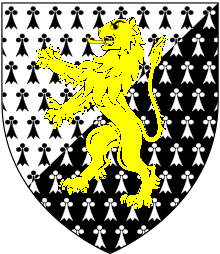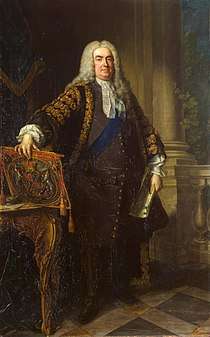Thomas Trevor, 1st Baron Trevor
Thomas Trevor, 1st Baron Trevor, PC (8 March 1658 – 19 June 1730) was a British judge and politician who was Attorney-General and later Lord Privy Seal.
The Lord Trevor | |
|---|---|
 Chief Justice Trevor | |
| Lord President of the Council | |
| In office 8 May – 19 June 1730 | |
| Monarch | George II |
| Prime Minister | Sir Robert Walpole |
| Preceded by | The Duke of Devonshire |
| Succeeded by | The Earl of Wilmington |

Biography
Trevor was the second son of John Trevor (1626–1672).[1] and was educated privately before entering the Inner Temple (1672) and Christ Church, Oxford. He was called to the bar in 1680.[2]
He was made King's Counsel in 1683 and was knighted and made Solicitor General in 1692, being promoted to Attorney-General in 1695. In 1701 Trevor was appointed Chief Justice of the Common Pleas. He was also a Privy Councillor (1702–1714) and First Commissioner of the Great Seal (1710). In 1712 he was created a peer as Baron Trevor of Bromham.[3]
On the accession of George I in 1714 he was deprived of his offices for alleged Jacobite sympathies, but from 1726 he was restored to favour as Lord Privy Seal (1726 to his death),[3] one of the Lords Justice Regents of the Realm (1727), Lord President of the Council (1730) and Governor of the Charterhouse.[2]
In 1707 he was elected a fellow of the Royal Society.[2]
Family
In 1690 he married Elizabeth Searle (d. 1702), daughter of John Searle of Finchley; their two sons, Thomas and John, succeeded their father in turn but died without male issue, the peerage devolving upon Trevor's son from his second marriage, Robert Hampden-Trevor, 1st Viscount Hampden.[4]
In 1704 he married Anne Bernard, (c.1670-1723), the daughter of Robert Weldon (or Weildon), mercer in Fleet Street, London. Anne had previously been married to Sir Robert Bernard of Brampton, with whom she had had six children.[5] Three of Trevor's sons succeeded in turn to his barony, and a fourth son, Richard Trevor (1707–1771), was bishop of St Davids from 1744 to 1752, and then bishop of Durham.[3]
Notes
- Chisholm 1911, p. 256.
- "Fellow details". Royal Society. Retrieved 28 January 2017.
- Chisholm 1911, p. 257.
- Rigg, James McMullen (1899). . In Lee, Sidney (ed.). Dictionary of National Biography. 57. London: Smith, Elder & Co. pp. 228–230.
- Palmer, Kathleen (2018). Ladies of Quality & Distinction. London: The Foundling Museum. p. 12.
References

Further reading
- Rigg, James McMullen (1899). . In Lee, Sidney (ed.). Dictionary of National Biography. 57. London: Smith, Elder & Co. pp. 228–230.
| Parliament of England | ||
|---|---|---|
| Preceded by Sir George Treby John Pollexfen |
Member of Parliament for Plympton Erle 1692–1698 With: John Pollexfen 1692–1695 Courtenay Croker 1695–1698 |
Succeeded by Martin Ryder Courtenay Croker |
| Preceded by Henry Pelham Thomas Pelham |
Member of Parliament for Lewes 1701 With: Thomas Pelham |
Succeeded by Henry Pelham Thomas Pelham |
| Legal offices | ||
| Preceded by Sir John Somers |
Solicitor General 1692–1695 |
Succeeded by Sir John Hawles |
| Preceded by Sir Edward Ward |
Attorney General 1695–1701 |
Succeeded by Sir Edward Northey |
| Preceded by Sir George Treby |
Chief Justice of the Common Pleas 1701–1714 |
Succeeded by Sir Peter King |
| Political offices | ||
| Preceded by The Duke of Kingston |
Lord Privy Seal 1726–1730 |
Succeeded by The Earl of Wilmington |
| Preceded by The Duke of Devonshire |
Lord President of the Council 1730 | |
| Peerage of Great Britain | ||
| New creation | Baron Trevor 2nd creation 1712–1730 |
Succeeded by Thomas Trevor |
